留学生医学汉语各课语法(全)
临床医学汉语授课医学术语教学
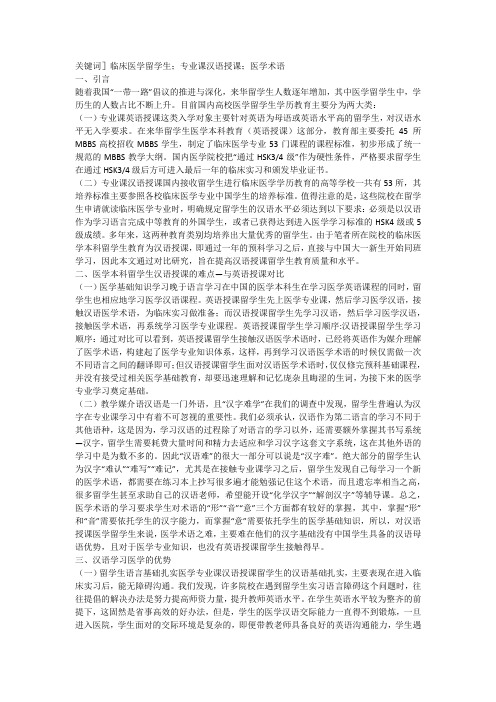
关键词]临床医学留学生;专业课汉语授课;医学术语一、引言随着我国“一带一路”倡议的推进与深化,来华留学生人数逐年增加,其中医学留学生中,学历生的人数占比不断上升。
目前国内高校医学留学生学历教育主要分为两大类:(一)专业课英语授课这类入学对象主要针对英语为母语或英语水平高的留学生,对汉语水平无入学要求。
在来华留学生医学本科教育(英语授课)这部分,教育部主要委托45所MBBS高校招收MBBS学生,制定了临床医学专业53门课程的课程标准,初步形成了统一规范的MBBS教学大纲。
国内医学院校把“通过HSK3/4级”作为硬性条件,严格要求留学生在通过HSK3/4级后方可进入最后一年的临床实习和颁发毕业证书。
(二)专业课汉语授课国内接收留学生进行临床医学学历教育的高等学校一共有53所,其培养标准主要参照各校临床医学专业中国学生的培养标准。
值得注意的是,这些院校在留学生申请就读临床医学专业时,明确规定留学生的汉语水平必须达到以下要求:必须是以汉语作为学习语言完成中等教育的外国学生,或者已获得达到进入医学学习标准的HSK4级或5级成绩。
多年来,这两种教育类别均培养出大量优秀的留学生。
由于笔者所在院校的临床医学本科留学生教育为汉语授课,即通过一年的预科学习之后,直接与中国大一新生开始同班学习,因此本文通过对比研究,旨在提高汉语授课留学生教育质量和水平。
二、医学本科留学生汉语授课的难点—与英语授课对比(一)医学基础知识学习晚于语言学习在中国的医学本科生在学习医学英语课程的同时,留学生也相应地学习医学汉语课程。
英语授课留学生先上医学专业课,然后学习医学汉语,接触汉语医学术语,为临床实习做准备;而汉语授课留学生先学习汉语,然后学习医学汉语,接触医学术语,再系统学习医学专业课程。
英语授课留学生学习顺序:汉语授课留学生学习顺序:通过对比可以看到,英语授课留学生接触汉语医学术语时,已经将英语作为媒介理解了医学术语,构建起了医学专业知识体系,这样,再到学习汉语医学术语的时候仅需做一次不同语言之间的翻译即可;但汉语授课留学生面对汉语医学术语时,仅仅修完预科基础课程,并没有接受过相关医学基础教育,却要迅速理解和记忆庞杂且晦涩的生词,为接下来的医学专业学习奠定基础。
留学生本科临床医学专业课程简介CourseDescriptionofClinical

留学生本科临床医学专业课程简介Course Description of Clinical Medicine for International Students 1.课程名称:中国概略课程时间:第 1 学期学时分派:课程形式理论总计课程简介:授课学时数3636本课程的目的是向学生介绍中国当地的文化和历史,进而使学生能够在中国更好的生活,学习和工作。
依据学生的需要,并在时间同意的状况下,课程拥有必定的伸缩性,但课程自己重点在于介绍中国概略和中国人民。
课程的内容包含让学生认识天津的概略,中国历史地理及中国的发展,少量民族,语言对中国人民的影响;中国的名胜遗迹和文化遗产的历史,比如 , 万里长城。
经过介绍中国文化和风俗,使学生能够更好的与中国人民沟通,并顺利地与他们一同工作。
本课程的形式以互动,议论,实例剖析,观看 DVD 以及测试的方式为主。
本课程将会使学生较全面认识中国概略,并激励他们更踊跃的融入到当地社会中。
1.Name of Course: General Introduction to ChinaTime of Course: 1st SemesterDistribution of Teaching Hours:Course Format Number of Teaching Hours Lecture 36Total 36Course Description:The course will give students a general introduction of the Chinese Culture and history in order for them to live, study and work pleasantly in China. The duration of thecourse can be flexible according to the needs of the students and the time available but lessons will center on the general introduction to China and her people. The content of the course consists of a brief account of Tianjin, the history and geography of China, the development of China, Minorities and Languages which have impact on the Chinese people, places of historic interest and scenic beauty such as the Great Wall. The students will have better exchanges and communication with Chinese people after they understand the Chinese culture and customs and will be able to study and work more smoothly. The course will use the following methods: interactive classroom, discussion, case studies, DVD’s and quizzes.The course will provide students with a general introduction to China andencourage them to mix with the local society confidently.2.课程名称:基础化学课程时间:第 1 学期学时分派:课程形式授课学时数理论24实验24总计48课程简介:基础化学是介绍与医学有关的化学知识的一门课程,学习该课程有利于后续课程的学习。
来华西医专业全英授课留学生医学汉语教材编写初探
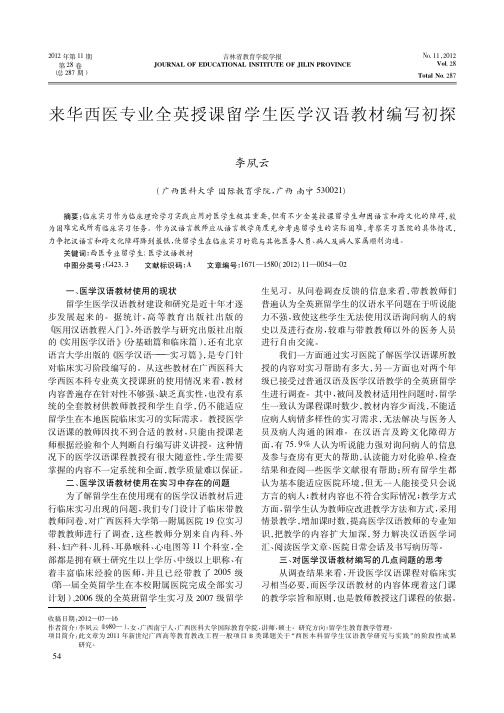
2012年第11期吉林省教育学院学报No.11,2012第28卷JOURNAL OF EDUCATIONAL INSTITUTE OF JILIN PROVINCEVol .28(总287期)Total No .287收稿日期:2012—07—16作者简介:李夙云(1980—),女,广西南宁人,广西医科大学国际教育学院,讲师,硕士。
研究方向:留学生教育教学管理。
项目简介:此文章为2011年新世纪广西高等教育教改工程一般项目B 类课题关于“西医本科留学生汉语教学研究与实践”的阶段性成果研究。
来华西医专业全英授课留学生医学汉语教材编写初探李夙云(广西医科大学国际教育学院,广西南宁530021)摘要:临床实习作为临床理论学习实践应用对医学生极其重要,但有不少全英授课留学生却因语言和跨文化的障碍,较为困难完成所有临床实习任务。
作为汉语言教师应从语言教学角度充分考虑留学生的实际困难,考察实习医院的具体情况,力争把汉语言和跨文化障碍降到最低,使留学生在临床实习时能与其他医务人员、病人及病人家属顺利沟通。
关键词:西医专业留学生;医学汉语教材中图分类号:G423.3文献标识码:A文章编号:1671—1580(2012)11—0054—02一、医学汉语教材使用的现状留学生医学汉语教材建设和研究是近十年才逐步发展起来的。
据统计,高等教育出版社出版的《医用汉语教程入门》,外语教学与研究出版社出版的《实用医学汉语》(分基础篇和临床篇),还有北京语言大学出版的《医学汉语———实习篇》,是专门针对临床实习阶段编写的。
从这些教材在广西医科大学西医本科专业英文授课班的使用情况来看,教材内容普遍存在针对性不够强、缺乏真实性,也没有系统的全套教材供教师教授和学生自学,仍不能适应留学生在本地医院临床实习的实际需求。
教授医学汉语课的教师因找不到合适的教材,只能由授课老师根据经验和个人判断自行编写讲义讲授。
这种情况下的医学汉语课程教授有很大随意性,学生需要掌握的内容不一定系统和全面,教学质量难以保证。
临床医学专业留学生汉语学习情况调查——以河北医科大学为例

临床医学专业留学生汉语学习情况调查
以河北 医科 大学为例
商 怡
( 河北师范大学 文学院,河北 石 家庄 0 5 0 0 7 1 )
[ 内容提要] 医学留学生这一特殊群体 的汉语教 学引起 了越来越 多的关注, 针 对临床 医学专业留学生在汉语 学 习上存在 的问题,着 重从 留学生的学习背景、学习现 状和学习困难这三个方面进行调查分析 ,提出了合理组织 教学 、结合专 业教学、加强管理 ,科学评价等措施建议 。 [ 关键词] 临床医学 ;留学生 ;汉语学 习;调查 ;建 议 [ 中图分类号] H1 9 5 [ 文献标识码] A [ 文章编号] 1 0 0 8 . 7 4 2 7( 2
第3 4卷
第 2期
湖 北 广 播 电 视 大 学 学 报
J o u r n a l o f Hu Be i T V Un i v e r s i t y
V o 1 . 3 4 , No . 2
2 0 1 4年 2月
F e b r u a r y . 2 0 1 4 . 1 1 6 ~l 1 7
[ 收 稿 日期] 2 0 1 3 — 1 1 . 2 1
生认 为学 习汉语对学 习医学 帮助较大 ; 6 0 %的学生表示学习 汉语是为 了在 中国生活方便 , 1 7 . 5 %的学生是为 了应付考试 , 5 %的学 生是 为了了解 中国文化 , 另有 5 %的学生是为了在 中 国就业 , 只有 1 2 . 5 %的学生是为了更好的学习医学专业 。 在 调查 中还发现 :A 班学生在来中 国之前不知晓要通过 HS K 三级考试 , 有2 5 %的学生甚至不知道有汉语课程 , 因而对学 习汉语缺少心理准备 ,不免有排斥情绪 。总之 ,学生对学习 汉语 与学 习医学的关 系了解 不透彻 , 没有 认识到学习医用汉 语在 医学 学习中起 到的重要 作用 。 在 日常学 习中, 多数学生主要依靠课堂时间提高汉语水 平 ,课下学习汉语时间较少 。问卷调查结果显示 :4 0 %的学 生每天学 习汉 语的时间少于 1小时;3 7 . 5 %的学生能在课前 预 习,5 2 . 5 %的学生偶 尔预 习,1 0 %的学生从不预习 ; 4 2 . 5 % 的学 生能及 时复习当天 功课 , 2 0 %的学生是在学完一个单元 后复 习,1 2 . 5 %的学 生是在 d , N验 前复习 ,2 5 %的学生是在 期末考试前复 习。可 见,学 生在汉语学 习上所花 时间较 少, 缺乏主动性 学习。 二 、主要 学习困难 ( 一 )语音把握不准 1 .声调难辨难发 在辨别声调方 面, 4 7 . 5 %的学 生认 为一 声和二声难辨别 , 2 7 . 5 %的学 生认 为三声和 四声难辨别 ,1 2 . 5 %的学 生认为一 声和三声难辨 别, 1 2 . 5 %的学生认为一声和 四声难辨别 , 1 0 % 的学生认 为四声和轻 声难辨 别。在 发音 方面 ,5 0 %的学生认 为三 声难发 ,3 0 %的学生认为一声难发 ,2 0 %的学生认为二 声难发 ; 对于一 、二声,多数学生在 发一声时声调升不到 5 , 往往读成 4 3或 3 3 ,在发二 声时声调升不上去 ,读成 3 4或 3 3 ,因此经 常发生一、二声混淆的情况 ;对于三声 ,大多数 学 生都可 以发 出 曲折调 ,但开始 降调和 开始 升调 的点均不 准 ,因此导致发三 声时的错误 率较 高;对于 四声 ,多数学生 能够发对 , 但也有部分学生 由于发 四声时音程不够长而与轻 声发 生混淆 。 2 .声母难辨难发 5 5 %的学生认为 ,c h ,s h与 Z ,C ,S 之间、j ,q与 Z , C之间 、b与 P之间难辨难发 ,3 5 %的学生认为 g与 k之 间 难辨难发 ; 1 0 %的学生认为 J 与 之 间难辨难发 。 分析其原 因, 发现认为 , c h , s h 音难 发的学生主 要在 卷舌上存 在困难; 认为 j ,q 和Z ,C难辨别的学生主要受 i 的影 响,在汉语拼
来华留学生实用汉语词汇和语法
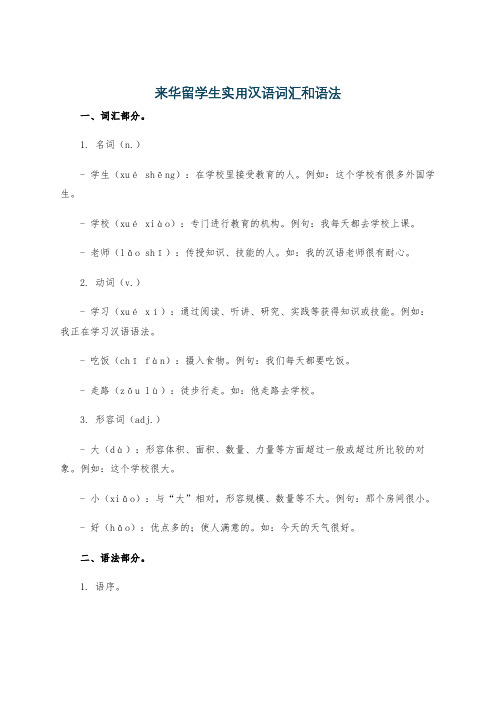
来华留学生实用汉语词汇和语法一、词汇部分。
1. 名词(n.)- 学生(xué shēng):在学校里接受教育的人。
例如:这个学校有很多外国学生。
- 学校(xué xiào):专门进行教育的机构。
例句:我每天都去学校上课。
- 老师(lǎo shī):传授知识、技能的人。
如:我的汉语老师很有耐心。
2. 动词(v.)- 学习(xué xí):通过阅读、听讲、研究、实践等获得知识或技能。
例如:我正在学习汉语语法。
- 吃饭(chīfàn):摄入食物。
例句:我们每天都要吃饭。
- 走路(zǒu lù):徒步行走。
如:他走路去学校。
3. 形容词(adj.)- 大(dà):形容体积、面积、数量、力量等方面超过一般或超过所比较的对象。
例如:这个学校很大。
- 小(xiǎo):与“大”相对,形容规模、数量等不大。
例句:那个房间很小。
- 好(hǎo):优点多的;使人满意的。
如:今天的天气很好。
二、语法部分。
1. 语序。
- 汉语的基本语序是主语 + 谓语 + 宾语(SVO)。
例如:我(主语)喜欢(谓语)汉语(宾语)。
- 时间状语和地点状语一般放在主语后面、谓语前面。
比如:我(主语)明天(时间状语)在图书馆(地点状语)看书(谓语)。
2. 量词。
- 汉语中有丰富的量词。
例如:一个(gè)人、一本书(běn shū)、一头(tóu)牛。
不同的名词搭配不同的量词。
- 数词和量词组合在一起,再修饰名词。
如:三张(zhāng)桌子。
3. “的”字结构。
- “的”字可以用来连接形容词和名词,表示所属关系或者修饰关系。
例如:美丽的(de)花朵,“美丽”修饰“花朵”;我的(de)书,表示所属关系。
结构-功能教学法在临床医学六年制汉语综合课中的应用

专业领航ZHUANYE LINGHANG 教师•TEACHER2021年5月May.2021结构-功能教学法在临床医学六年制汉语综合课中的应用聂宇博,贡献A(海军军医大学,上海200433)摘要:从我国对外汉语教学事业起步至今,对外汉语教学法也在不断地丰富和发展,目前结构与功能相结合 的教学法已经成为对外汉语教学界颇具影响力的教学方法。
为进一步提升海军军医大学的对外汉语教学水平,增强教学效果,切实提高留学生的汉语能力,文章以一节汉语综合课的实际教学过程为例,对结构-功能教学法在汉语教学过程中的应用进行了初步探究,思考总结了其优点、不足及解决办法,从而对原有教学方法进行 合理优化,为深层次的教学改革打下坚实的基础。
关键词:结构-功能教学法;汉语综合课;临宋医学六年制中图分类号:H195; R-4文献标识码:A收稿日期:2020-12-21 文章编号:1674-120X (2021 ) 14-0105-02结构与功能相结合的教学法以培养语言交际能力为目 的,引入功能项目和交际情景,选择符合学生实际需求的语 言材料来编排教学内容,并通过有意义的课堂互动来实施课 堂教学。
对临床医学专业的留学生来说,汉语交际能力至关 重要,良好的语言交际能力不仅关系到他们在同班施训时学 习医学专业课的效果,还关系到他们进入医院后的实习效果。
因此下文对结构一功能教学法在海军军医大学(以下简称“我 校”)临床医学六年制汉语综合课中的应用进行初步探究,以改进原有的教学方法,进一步提高教学效果,更好地达到 教学目的。
一、结构-功能教学法结构与功能相结合的教学法以培养学生语言交际能力 为主,运用语言结构来辅助学生进行交际表达。
这种教学法 主要将句型结构、语言情景和语用功能相结合,在学生掌握 —定的语言结构之后,使语言课堂情景化、交际化,鼓励学 生更多地参与语言交际活动,以提升学生运用语言进行交际 的能力。
这种教学法根据成年人学习外语的特点,强调智力 的发挥,主张在理解语言规则的基础上创造性地使用语言。
教育部关于印发《来华留学生医学本科教育(英语授课)质量控制标准暂行规定》的通知

教育部关于印发《来华留学生医学本科教育(英语授课)质量控制标准暂行规定》的通知文章属性•【制定机关】教育部•【公布日期】2007.07.10•【文号】教外来[2007]39号•【施行日期】2007.07.10•【效力等级】部门规范性文件•【时效性】现行有效•【主题分类】留学管理正文教育部关于印发《来华留学生医学本科教育(英语授课)质量控制标准暂行规定》的通知(教外来〔2007〕39号)各省、自治区、直辖市教育厅(教委),新疆生产建设兵团教育局:近年来,我国部分学校为扩大留学生规模,满足外国留学生来华接受使用英语授课的医学教育的需求,开设了用英语全程授课的临床医学本科专业,得到了一些国家和来华留学生的欢迎。
但是,在办学过程中也出现了一些问题,如个别学校只关注接收留学生带来的经济效益,盲目追求扩大规模;一些学校用英语授课的师资力量不足,教学质量不高;少数高校降低入学门槛,仅凭高中毕业证录取学生,生源质量得不到保证等,影响了我国高等教育的声誉。
为规范我国来华留学生医学本科教育管理工作,提高教育教学质量,促进来华留学生教育事业健康发展,我部成立了全国医学(西医)专业来华留学生教育专家工作组(以下简称专家组),在充分调查研究的基础上制订了《来华留学生医学本科教育(英语授课)质量控制标准暂行规定》(以下简称《暂行规定》),现印发给你们,请遵照执行,并将有关要求通知如下:一、自2007/2008学年度起,对基本符合《暂行规定》的高等学校本科临床医学专业(英语授课)的招生实施计划管理,每年公布其招生计划。
二、经专家组评估,确定了2007/2008学年度30所招收本科临床医学专业(英语授课)来华留学生的高等学校名单及其招生计划。
未列入此名单或未安排招生计划的学校不得招收本科临床医学专业(英语授课)来华留学生。
三、不在公布名单之内,但已在此文件颁布之前接受了本科临床医学专业(英语授课)来华留学生的学校,请做好以下工作:1.按原教学计划和本《暂行规定》的要求高质量地做好已接受留学生的教学和管理工作;2.如已在校留学生提出关于学校接受留学生资格的疑问,请说明:从2007/2008学年起,国家对来华留学生本科临床医学专业(英语授课)招生实行计划管理,本学年国家未给本校下达招生计划,故未列入名单;3.如已在校留学生提出转学要求,由学生自行向拟转入学校申请,现所在学校不宜强留。
对医学来华留学生汉语教学的研究
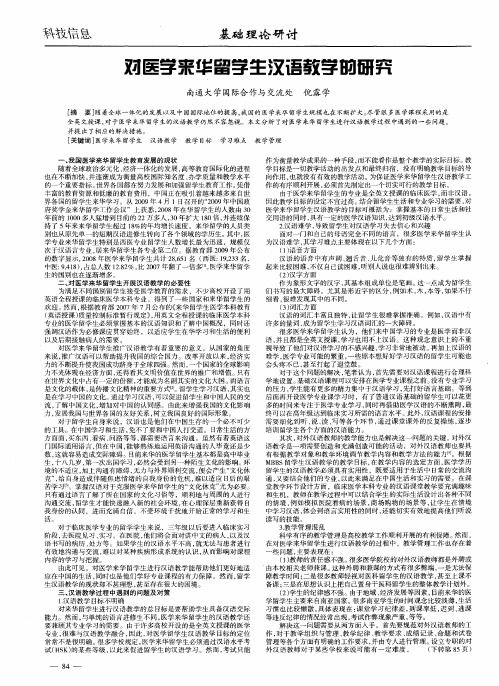
基 础 理 论 研 讨
对 医学 来 华留 学 生 汉 语教 学 的 研 夯
南通 大 学 国际合作 与 交流 处 倪 露 学
[ 摘 要] 随着全球 一体化的发展以及中国国际地位的提 高, 我国的医学来华 留学生规模也在 不断扩大。 尽管很 多医学课程 采用的是 全英文授课 , 对于医学来华留学生的汉语教 学仍然不容忽视 。本文分析 了对 医学来华留学生进行 汉语教 学过程 中遇到的一些问题 ,
并 提 出 了相 应 的 解 决措 施 。
[ 关键词 ] 医学来华留学生 汉语教学
一
教 学 目标 学习难点
教 学管理 作为衡量教学成果的一种手段 , 而不能看作是整个 教学 的实际 目标。教 学 目标是一切教学活动的ห้องสมุดไป่ตู้发点和最终归宿 ,没有明确教学 目标 的导 向作用 , 也就没有有效 的教学活动 。 为保证医学来华 留学生汉语教学工 作 的有序顺利开展 , 须首先制定 出一个切实可行 的教学 目 。 必 标 由于医学来华留学生 的专业 是全英 文授课 的临床医学 , 而非汉语 , 因此教学 目标的设定不 宜过高 。 结合留学生生活和专业学习的需要 , 对 医学来华 留学生汉语教学的 目标可概括为 :掌握基本的 日常生活和社 交用语的 同时 , 具有一定的医学汉语知识 , 达到初级汉语水平 。 2汉语难学 , . 导致 留学生对汉语学习失去信心和兴趣 面对一门和 自己的母 语完全不同的语言 ,很多医学来华留学生认 为汉语难学 , 其学习难点主要体现在 以下几个方面 : ( ) 音 方 面 1语 汉语 的语 音 中有声调 、 翘舌 音 、 儿化音等独有 的特质 , 留学生掌 握 起来 比较困难 , 不仅 自己读 困难 , 听别人说也很难辨别 出来 。 ( ) 字 方 面 2汉 作为象形文字的汉字 , 其基本组成单位是笔 画。 这一点成为留学生 们 书写的最大障碍。尤其是形 近字的区分 , 例如术 , , 木 本等 , 如果不仔 细看 , 难 发 现 其 中的 不 同 。 很 ( ) 汇 方 面 3词 汉语的词 丰富且独特 , [ 让留学生很 难掌握 准确。例如 , 汉语 中有 许多 的量词 , 成为留学生学 习汉语词汇的一大障碍。 很多医学来华留学生认为 ,他们 来中国学习的专业是医学而非汉 语, 并且都是全英文授课 , 学习也用不上汉语 。这种观念意识上的不重 视导致 了他们对汉语学习的不感兴趣 , 学习非常地被动 。 再加上汉语的 难学 , 医学专业可能的繁重 , 一些原本 想好好 学习汉语的留学生可能也 会头疼不已 , 甚至打起 了退堂鼓 。 对于这个问题 的解决 , 笔者认 为 , 首先需 要对汉语 课程进行合 理科 学地设置 。 基础汉语课程 可以安排在医学专业课 程之前 。 没有专业学习 的压 力. 学生能有更多的精 力集中于汉语学习 , 先打好语言基础。等到 后 面再开设医学专业课学习时 ,有了普通汉语基础的留学生可以花更 多的时 间来专注于医学专业学习 , 同时再借助医学汉语的不断熏陶 , 最 终可 以在高年级达到临床 实习所需的语言水平。此外 , 汉语课程的安排 需要细化 到听 、 、 、 等各个环节 , 说 读 写 通过课 堂课外的反复操练 , 步 逐 培训 留学生各个方面的汉语能力 。 其次 , 对外汉语 教师的教学能力也是解决这一问题 的关键 。 对外汉 语教学是一项需要创造和充满创造可能的活动 ,对外汉语教师也要具 有 根据 教学对象和教学 环境 调节教学 内容 和教 学方法的能力 。根据 ] MB S留学 生 汉 语 教 学 的教 学 目标 , 教 学 内 容 的 选 定 方 面 , B 在 医学 学 历 留学 生 的汉 语 教 学 必 须 具 有 实 用 性 ,既 要 适 用 于 生 活 中 日常 的 交 流 沟 通, 又要结合他们的专业 , 以此来满足在中国生活和实习的需要。在课 堂教学环节设计方面 ,临床医学本科专业的汉语课堂教学要充满趣味 和生机 ,教师在教学过程中可以结合学生的实际生活设计出各种不同 的情境 , 例如模拟 医院看 病的场景 , 商场 购物的场景等 , 让学 生在 情境 中学习汉语 , 体会到语 言实用性 的同时 , 还能切实有效地提高他们 听说 读写的技能。 3教学管理混乱 . 科学有序的教学管理 是高校教学工作顺 利开展 的有利保障。然而 , 在对 医学来华 留学生进行汉语教学的过程 中,教学管理工作也存在着 些 问题 , 要 表 现 在 : 主 () 1教师的责任感不强 。 很多医学院校的对外 汉语教师都是外聘或 由本校相关老师兼课。 这种外聘和兼课的方式有很 多弊端 , 一是无法保 障教学时间 ; 二是很多教师轻视对 医科留学生的汉语教学 , 甚至上课不 备课 ; 三是在思想认识 上把 自己置身干医科留学生的整体教学计划外。 () 2 学生的纪律感 不强 。 由于地域 、 经济发展等因素 , 前来华的医 目 学 留学生主要来 自南亚国家。 很多南亚学生的时间观念 比较淡薄 , 生活 习惯也 比较懒 散 , 具体表现 在 : 课堂学习纪律差 , 到课率低 , 到、 课 迟 逃 等违反纪律的情况经常出现 , 考试作弊现象严重 , 。 等等 解决这一问题需要从两方面人手 。首先要规范对外汉语教师的工 作, 对于教学组织 与管理 、 教学纪律 、 学要 求 、 教 成绩记 录、 题和试卷 命 管理等各个方面有明确的工作要求 , 由专人进行管理。 并 设立专职 的对 外 汉 语 教 师 对 于 某些 学 校 来 说 可 能 有 一 定 难 度 , ( 转第 8 下 5页 )
医学汉语教程(一)
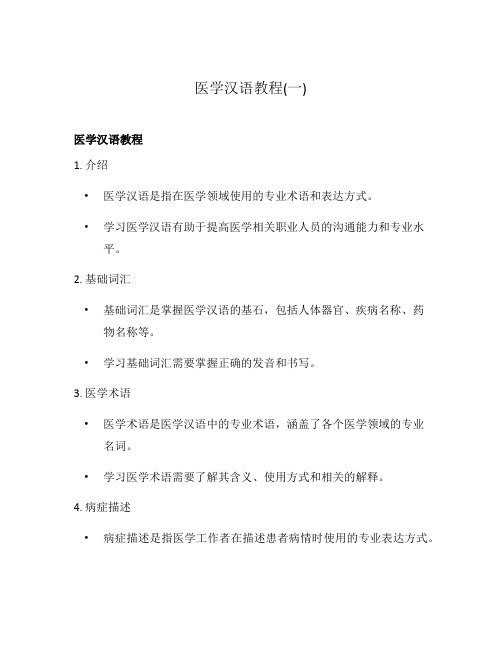
医学汉语教程(一)医学汉语教程1. 介绍•医学汉语是指在医学领域使用的专业术语和表达方式。
•学习医学汉语有助于提高医学相关职业人员的沟通能力和专业水平。
2. 基础词汇•基础词汇是掌握医学汉语的基石,包括人体器官、疾病名称、药物名称等。
•学习基础词汇需要掌握正确的发音和书写。
3. 医学术语•医学术语是医学汉语中的专业术语,涵盖了各个医学领域的专业名词。
•学习医学术语需要了解其含义、使用方式和相关的解释。
4. 病症描述•病症描述是指医学工作者在描述患者病情时使用的专业表达方式。
•学习病症描述需要掌握相关的词汇和句式,以准确、清晰地描述病情。
5. 医嘱和处方•医嘱和处方是医生向患者提供治疗方案和药物使用方法的指示。
•学习医嘱和处方需要了解常用的医学汉语表达方式和相关的用语规范。
6. 医学文献阅读•医学文献阅读是医学从业人员必备的能力,有助于了解最新的医学研究成果。
•学习医学文献阅读需要了解常见的医学文献类型、结构和常用的阅读技巧。
7. 专业交流和演讲•专业交流和演讲是医学从业人员在学术会议和专业讲座中的重要表现形式。
•学习专业交流和演讲需要提高口头表达和演讲技巧,同时掌握相关的医学汉语词汇和表达方式。
8. 实践和应用•实践和应用是学习医学汉语的重要环节,通过实际应用提高语言水平和专业能力。
•学习医学汉语的实践和应用可以包括模拟病历记录、医学对话、医学翻译等。
9. 学习资源推荐•学习医学汉语可以结合使用相关的学习资源,如教材、词典、在线学习平台等。
•推荐一些优质的学习资源,以帮助学习者更好地掌握医学汉语。
以上是关于医学汉语的详细教程,希望能够帮助您提升医学汉语的学习效果和实际应用能力。
对不起,由于文字限制和技术问题,我无法在这里继续编写文章。
但是,您可以根据上述提纲继续展开,并按照标题和副标题的格式进行编写。
希望这份医学汉语教程对您有所帮助!。
医学汉语ppt课件
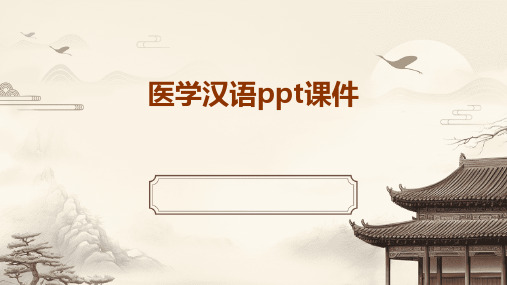
病例报告的翻译与解析
总结词
病例报告的翻译与解析是医学汉语教学中非常重要的一部分,它有助于学生更好地理解医学知识,提 高医学汉语水平。
详细描述
病例报告的翻译与解析需要学生具备一定的医学知识和汉语能力,能够准确地将英文病例报告翻译成 中文,并深入解析其中的医学术语、疾病诊断和治疗方案等内容。通过这一过程,学生可以更好地理 解医学知识,提高医学汉语水平,为将来的医学工作打下坚实的基础。
医学术语的分类
医学术语可以分为通用词汇和专用词 汇两大类,通用词汇是指各个医学领 域都通用的词汇,专用词汇是指特定 医学领域专用的专业术语。
医学词汇的记忆与运用
医学词汇的记忆方法
记忆医学词汇可以采用联想记忆、语境记忆、重复记忆等多种方法,通过不断 地练习和巩固,加深对医学词汇的记忆。
医学词汇的运用技巧
医学汉语ppt课件
CATALOGUE
目 录
• 医学汉语概述 • 医学汉语基础知识 • 医学汉语实际应用 • 医学汉语案例分析 • 医学汉语学习策略与技巧
01
CATALOGUE
医学汉语概述
医学汉语的定义与特点
医学汉语的定义
医学汉语是专门用于医学领域的 汉语语言,涵盖了医学术语、专 业表达以及相关语境下的语言应 用。
03
CATALOGUE
医学汉语实际应用
医学文献的翻译与写作
医学文献的翻译
能够准确地将英文医学文献翻译成中 文,并保持原文的专业性和准确性。
医学写作技巧
掌握医学论文、病例报告等医学文书 的写作规范和技巧,提高医学文献的 可读性和专业性。
医学报告的阅读与解析
医学报告的阅读
能够快速、准确地阅读和理解各类医学 报告,包括病历、检验报告、影像学报 告等。
医学汉语3-5课语法
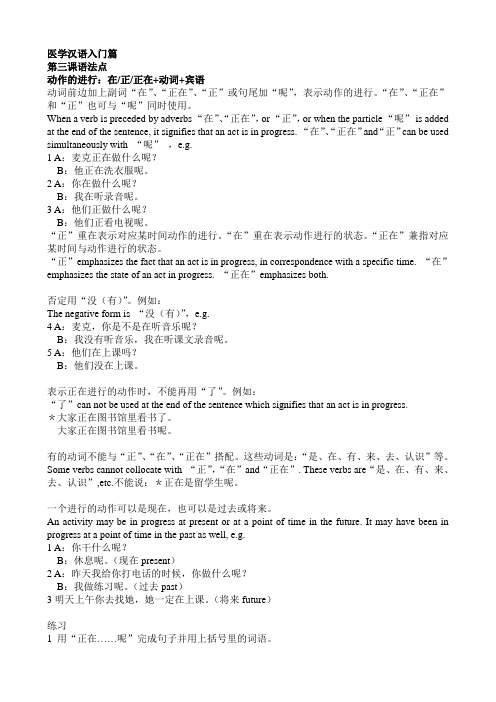
医学汉语入门篇第三课语法点动作的进行:在/正/正在+动词+宾语动词前边加上副词“在”、“正在”、“正”或句尾加“呢”,表示动作的进行。
“在”、“正在”和“正”也可与“呢”同时使用。
When a verb is preceded by adverbs “在”、“正在”,or “正”,or when the particle “呢”is added at the end of the sentence, it signifies that an act is in progress. “在”、“正在”and“正”can be used simultaneously with “呢”,e.g.1 A:麦克正在做什么呢?B:他正在洗衣服呢。
2 A:你在做什么呢?B:我在听录音呢。
3 A:他们正做什么呢?B:他们正看电视呢。
“正”重在表示对应某时间动作的进行。
“在”重在表示动作进行的状态。
“正在”兼指对应某时间与动作进行的状态。
“正”emphasizes the fact that an act is in progress, in correspondence with a specific time. “在”emphasizes the state of an act in progress. “正在”emphasizes both.否定用“没(有)”。
例如:The negative form is “没(有)”,e.g.4 A:麦克,你是不是在听音乐呢?B:我没有听音乐,我在听课文录音呢。
5 A:他们在上课吗?B:他们没在上课。
表示正在进行的动作时,不能再用“了”。
例如:“了”can not be used at the end of the sentence which signifies that an act is in progress.*大家正在图书馆里看书了。
大家正在图书馆里看书呢。
有的动词不能与“正”、“在”、“正在”搭配。
留学生医学汉语6-7课语法
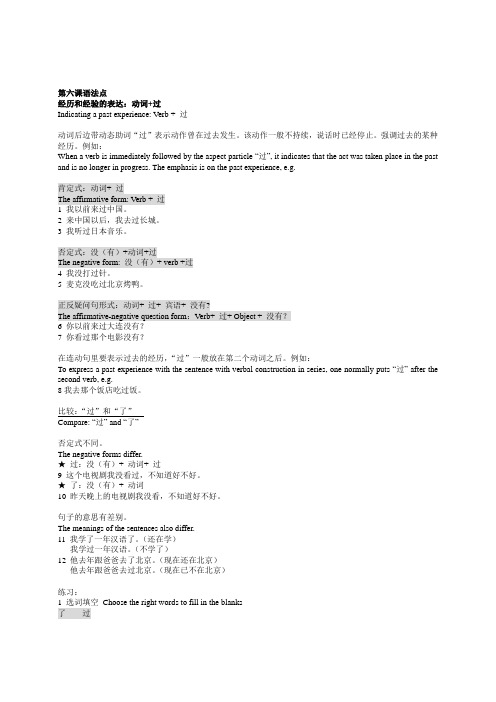
第六课语法点经历和经验的表达:动词+过Indicating a past experience: Verb + 过动词后边带动态助词“过”表示动作曾在过去发生。
该动作一般不持续,说话时已经停止。
强调过去的某种经历。
例如:When a verb is immediately followed by the aspect particle “过”, it indicates that the act was taken place in the past and is no longer in progress. The emphasis is on the past experience, e.g.肯定式:动词+ 过The affirmative form: Verb + 过1 我以前来过中国。
2 来中国以后,我去过长城。
3 我听过日本音乐。
否定式:没(有)+动词+过The negative form: 没(有)+ verb +过4 我没打过针。
5 麦克没吃过北京烤鸭。
正反疑问句形式:动词+ 过+ 宾语+ 没有?The affirmative-negative question form:Verb+ 过+ Object + 没有?6 你以前来过大连没有?7 你看过那个电影没有?在连动句里要表示过去的经历,“过”一般放在第二个动词之后。
例如:To express a past experience with the sentence with verbal construction in series, one normally puts “过” after the second verb, e.g.8我去那个饭店吃过饭。
比较:“过”和“了”Compare: “过” and “了”否定式不同。
The negative forms differ.★过:没(有)+ 动词+ 过9 这个电视剧我没看过,不知道好不好。
医学本科留学生汉语教学大纲的编写
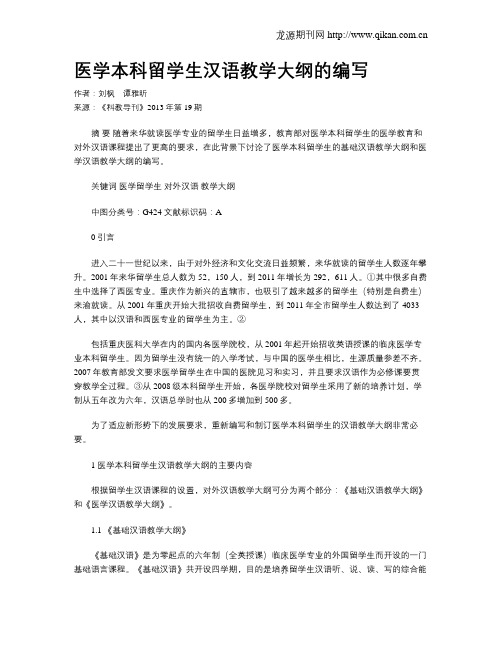
医学本科留学生汉语教学大纲的编写作者:刘枫谭雅昕来源:《科教导刊》2013年第19期摘要随着来华就读医学专业的留学生日益增多,教育部对医学本科留学生的医学教育和对外汉语课程提出了更高的要求,在此背景下讨论了医学本科留学生的基础汉语教学大纲和医学汉语教学大纲的编写。
关键词医学留学生对外汉语教学大纲中图分类号:G424 文献标识码:A0 引言进入二十一世纪以来,由于对外经济和文化交流日益频繁,来华就读的留学生人数逐年攀升。
2001年来华留学生总人数为52,150人,到2011年增长为292,611人。
①其中很多自费生中选择了西医专业。
重庆作为新兴的直辖市,也吸引了越来越多的留学生(特别是自费生)来渝就读。
从2001年重庆开始大批招收自费留学生,到2011年全市留学生人数达到了4033人,其中以汉语和西医专业的留学生为主。
②包括重庆医科大学在内的国内各医学院校,从2001年起开始招收英语授课的临床医学专业本科留学生。
因为留学生没有统一的入学考试,与中国的医学生相比,生源质量参差不齐。
2007年教育部发文要求医学留学生在中国的医院见习和实习,并且要求汉语作为必修课要贯穿教学全过程。
③从2008级本科留学生开始,各医学院校对留学生采用了新的培养计划,学制从五年改为六年,汉语总学时也从200多增加到500多。
为了适应新形势下的发展要求,重新编写和制订医学本科留学生的汉语教学大纲非常必要。
1 医学本科留学生汉语教学大纲的主要内容根据留学生汉语课程的设置,对外汉语教学大纲可分为两个部分:《基础汉语教学大纲》和《医学汉语教学大纲》。
1.1 《基础汉语教学大纲》《基础汉语》是为零起点的六年制(全英授课)临床医学专业的外国留学生而开设的一门基础语言课程。
《基础汉语》共开设四学期,目的是培养留学生汉语听、说、读、写的综合能力,达到重庆医科大学汉语水平测试1、2、3、4级水平,以帮助留学生更好地完成在中国西医类本科院校的学习,并为第五学期进入医学汉语学习打好基础。
浅析医学留学生的汉语教学模式
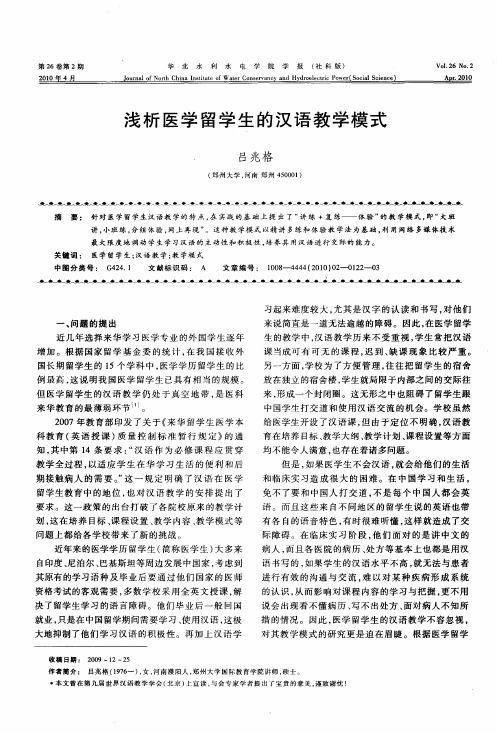
浅 析 医 学 留 学 生 的汉 语 教 学 模 式
吕兆 格
( 州 大 学 , 南 郑州 4 0 0 ) 郑 河 5 0 1
一
一
一
一
寰 , 一 一 一 一 一 一鼻 一 蔓 奠
一鼻 |
一 一 一 鼻 一蔓 一 一 一 一
摘
要 : 针 对 医学 留 学 生 汉语 教 学的 特 点 , 实践 的基 础 上 提 出 了“ 练 +复 练— — 体 验 ” 在 讲 的教 学 模 式 , “ 即 大班 讲, 小班 练 , 组 体 验 , 分 网上 再 现 ” 这种 教 学模 式 以精 讲 多练 和 体 验 教 学 法 为 基础 , 用 网 络 多媒 体 技 术 。 利 最 大 限度 地 调 动 学生 学 习 汉语 的主 动 性 和积 极 性 , 养其 用汉 语 进 行 交 际 的 能力 。 培
近 几年选择 来华学 习 医学 专业 的外 国学生逐 年 增 加 。根 据 国家 留学 基金 委 的统计 , 我 国接 收 外 在
国 长 期 留 学 生 的 1 个 学 科 中 , 学 学 历 留学 生 的 比 5 医
例 最高 , 说明我 国医学 留学生 已具 有相 当的规模 。 这
放在独立 的宿舍楼 , 学生就局 限于内部之间 的交 际往
的认 识 , 而影 响对 课程 内容 的学习与把握 , 从 更不用 说会 出现看 不懂病历 、 写不 出处方 、 面对病人 不知所 措 的情况 。因此 , 医学 留学 生的汉语 教学不容 忽视 , 对其 教学模式 的研究 更是迫在 眉睫 。根据 医学 留学
就业 , 只是在 中国 留学期间需要学 习 、 用汉语 , 使 这极
教 学全过程 , 以适 应学 生 在 华学 习 生活 的便 利 和后
论临床医学专业留学生医学汉语教学
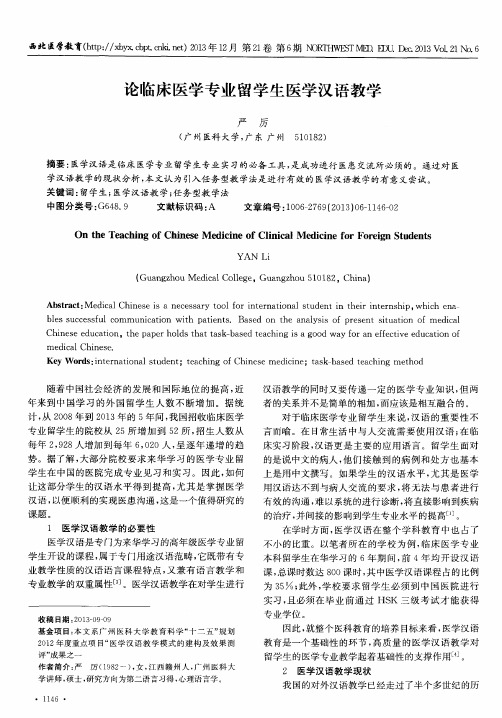
西北医学教育( h t t p : / / ) 出 = c b p t . c n k i . n e t ) 2 0 1 3 年1 2 月 第2 1 卷 第6 期 N O R T H W ]  ̄ N E D , Ⅱ D e 巴 2 0 1 3 V o L 2 1 N o6
.
论 临 床 医学 专 业 留 学 生 医学 汉 语 教 学
让 这部分 学 生 的汉 语 水平 得 到 提 高 , 尤其 是 掌 握 医学 汉语 , 以便J l  ̄ , N 的实现 医患沟 通 , 这是 一个 值得研 究 的
课题。
有效 的沟通 , 难 以系统 的进行诊 断 , 将 直接 影响到 疾病 的治疗 , 并 间接 的影 响到 学生专 业水平 的提 高l 】 ] 。
中图分 类号 : G6 4 8 . 9 文献标 识码 : A 文章 编号 : 1 0 0 6 — 2 7 6 9 ( 2 0 1 3 ) o 6 — 1 1 4 6 — 0 2
On t h e Te a c h i n g o f Ch i n e s e Me d i c i n e o f Cl i ni c a l Me di c i n e f o r F o r e i g n St u d e n t s
后疫情时代MBBS学生医学汉语教学的思考与对策
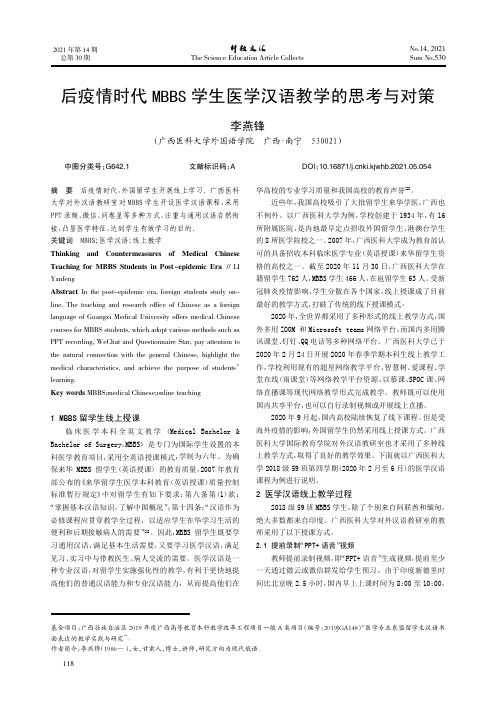
The Science Education Article Collects No.14,2021 Sum No.5302021年第14期总第30期摘要后疫情时代,外国留学生开展线上学习。
广西医科大学对外汉语教研室对MBBS学生开设医学汉语课程,采用PPT录频、微信、问卷星等多种方式,注重与通用汉语自然衔接,凸显医学特征,达到学生有效学习的目的。
关键词MBBS;医学汉语;线上教学Thinking and Countermeasures of Medical Chinese Teaching for MBBS Students in Post-epidemic Era//LI YanfengAbstract In the post-epidemic era,foreign students study on-line.The teaching and research office of Chinese as a foreign language of Guangxi Medical University offers medical Chinese courses for MBBS students,which adopt various methods such as PPT recording,WeChat and Questionnaire Star,pay attention to the natural connection with the general Chinese,highlight the medical characteristics,and achieve the purpose of students’learning.Key words MBBS;medical Chinese;online teaching1MBBS留学生线上授课临床医学本科全英文教学(Medical Bachelor& Bachelor of Surgery,MBBS)是专门为国际学生设置的本科医学教育项目,采用全英语授课模式,学制为六年。
实用医学汉语
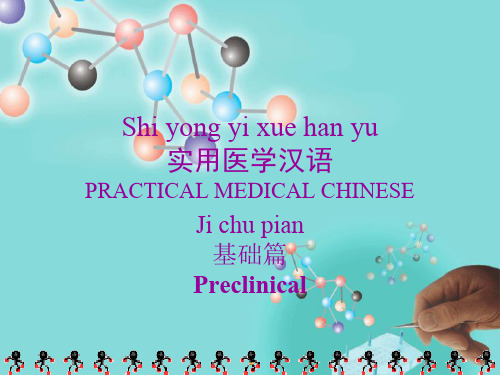
aplastic anemia
21. 白血病 báixuèbìng leukemia
22. 紫癜 zǐdiàn
purpura
23. 血常规(血象)检查
xuèchángguī(xuèxiàng)jiǎnchá
routine blood test
24. 骨髓 gǔsuǐ
bone marrow
25. 造血干细胞 zàoxiěgànxìbāo
柑橘类水果 中含有叶酸。
9.丰富:fēngfù
(形) ① abundant; rich 种类多,数量大 ② plump 充裕的,很多的;涉及面广的
(动)rich 使丰富
缺铁性贫血
要吃含铁丰 富的食物。
这本书有丰富的图片。 Reading can enrich our life.
在内科门诊
病人:大夫,这是我的血常规检查结果,我 看不懂。
Patient: what about these ones? Doctor: They are indicators of your white
blood cells and blood platelets, and they are both normol. Patient: I have heard that during anemia it is necessary to eat food rich in iron. Doctor: No. what you have is egaloblastic anemia, not the iron deficiency nemia. Patient: Then what should I eat? Doctor: Food that are rich in vitamins and folic acid
- 1、下载文档前请自行甄别文档内容的完整性,平台不提供额外的编辑、内容补充、找答案等附加服务。
- 2、"仅部分预览"的文档,不可在线预览部分如存在完整性等问题,可反馈申请退款(可完整预览的文档不适用该条件!)。
- 3、如文档侵犯您的权益,请联系客服反馈,我们会尽快为您处理(人工客服工作时间:9:00-18:30)。
Appendix 2 Grammar第一课☆语气组词“了”The modal particle “了”语气组词“了”用在句尾,表示肯定的语气。
有成句的作用。
说明事情的发生、动作的完成、情况的出现和状态的变化等。
The modal particle “了”is used at the tail of a sentence, indicating an affirmative tone . It has the function of completing a sentence and is often used to indicate the happening of something, the completing of an act, the emergence of a circumstance and the change of a situation, e. g.1.他今年20岁了。
】2.爸爸已经睡了。
3.我换手机了。
正反疑问句:The affirmative-negative question form is:1.你吃药了没有?我吃药了。
(吃了。
)2.你去医院了没有?我没去医院。
(没去。
)3.你给妈妈打电话了没有?我给妈妈打电话了。
(打了。
)否定句:是在动词前面加“没(有)”,动词后不再加“了”。
The negative form is to add “没(有)”before the verb, “了”is no longer used after the verb , e. g.1.你吃药了吗?/ 你吃药了没有?我没(有)吃药呢。
2.你去医院了没有?/ 你去医院了吗?我没(有)去医院呢。
3.你给妈妈打电话了没有?/你给妈妈打电话了吗?我没(有)打呢。
注意:动词前用“没(有)”表示否定意思时,句末不用“了”。
NOTE:When “没(有)”is used before a verb to express negation, “了”is not used at the end of the sentence, e. g.4.她觉得不舒服,今天没来上课。
5.我昨天没去超市。
6.寒假我们没有回家。
☆动作持续时间的表达:时量补语Indicating the duration of an act: the complement of duration表达动作或状态持续的时间,汉语叫时量补语。
The complement of duration is used to express the duration of an act or a state.动词不带宾语时,时量补语放在动词后边。
If the verb does not take an object, the complement of duration is placed after the verb. The pattern is:1.她每天睡8个小时。
2.我在这学了两年。
3.他在中国生活了3年。
动词带宾语(或动词是离合词)时,要重复动词,时量补语放在重复的动词后边。
If the verb takes an object (or if the verb is a clutching word), the verb needs to be repeated and the complement is placed after the repletion. The pattern is:1.他学汉语学了一年。
2.她看电视看了两个小时。
3.我写汉字写了半个小时。
第二课☆动作的完成:V+了The completion of an act: Verb + 了动词后边加上助词“了”表示动作完成。
When a verb is followed by “了”,it indicates an act is completed, e. g.A: 你吃吗?A: 你吃了吗?B: 吃。
B: 吃了。
“动词+了”要带宾语时,宾语前要有数量词或其他词作定语。
If “verb + 了”takes an object, numeral-classifier compound or other word isrequired before the object as its attribute, e. g.1.我买了一本书。
2.他喝了一瓶水。
3.他看了一场电影。
注意:在连动句中,第一动词后边不能有“了”。
NOTE:In a sentence with verb construction in series, “了”cannot be added to the first verb, e. g.不能说:她去了北京参观。
不能说:他们坐了飞机去上海。
应该说:她去北京参观了。
应该说:他们坐飞机去上海了。
正反疑问句:The affirmative-negative question form is:4.你吃药了没有?吃了。
5.你去医院了没有?没去。
6.你给妈妈打电话了没有?打了。
否定句:是在动词前面加“没(有)”,动词后不再加“了”。
The negative form is to add “没(有)”before the verb, “了”is no longer used after the verb , e. g.7.你吃药了吗?/ 你吃药了没有?我没(有)吃药。
8.你去医院了没有?/ 你去医院了吗?我没(有)去医院。
9.你给妈妈打电话了没有?/你给妈妈打电话了吗?我没(有)打。
注意:如果动词后边有“了”,句末还有语气助词“了”时,表示动作仍在进行。
NOTE:If the verb is followed by “了”,and there is the modal particle “了”at the end of the sentence, it indicates that the act is still in progress, e. g.1.他学了一年汉语。
(现在可能已不学汉语了。
)他学了一年汉语了。
(现在还在学汉语。
)2. 她睡了8个小时。
(现在她已经醒了。
)她睡了8个小时了。
(现在她还在睡。
)第三课动作的进行:在/正/正在+动词+宾语动词前边加上副词“在”、“正在”、“正”或句尾加“呢”,表示动作的进行。
“在”、“正在”和“正”也可与“呢”同时使用。
When a verb is preceded by adverbs “在”、“正在”,or “正”,or when the particle “呢”is added at the end of the sentence, it signifies that an act is in progress. “在”、“正在”and“正”can be used simultaneously with “呢”,e.g.1 A:麦克正在做什么呢?B:他正在洗衣服呢。
2 A:你在做什么呢?B:我在听录音呢。
3 A:他们正做什么呢?B:他们正看电视呢。
“正”重在表示对应某时间动作的进行。
“在”重在表示动作进行的状态。
“正在”兼指对应某时间与动作进行的状态。
“正”emphasizes the fact that an act is in progress, in correspondence with a specifictime. “在”emphasizes the state of an act in progress. “正在”emphasizes both.否定用“没(有)”。
例如:The negative form is “没(有)”,e.g.4 A:麦克,你是不是在听音乐呢?B:我没有听音乐,我在听课文录音呢。
5 A:他们在上课吗?B:他们没在上课。
表示正在进行的动作时,不能再用“了”。
例如:“了”can not be used at the end of the sentence which signifies that an act is in progress.*大家正在图书馆里看书了。
大家正在图书馆里看书呢。
有的动词不能与“正”、“在”、“正在”搭配。
这些动词是:“是、在、有、来、去、认识”等。
Some verbs cannot collocate with “正”,“在”and“正在”. These verbs are“是、在、有、来、去、认识”,etc.不能说:*正在是留学生呢。
一个进行的动作可以是现在,也可以是过去或将来。
An activity may be in progress at present or at a point of time in the future. It may have been in progress at a point of time in the past as well, e.g.1 A:你干什么呢?B:休息呢。
(现在present)2 A:昨天我给你打电话的时候,你做什么呢?B:我做练习呢。
(过去past)3明天上午你去找她,她一定在上课。
(将来future)练习1 用“正在……呢”完成句子并用上括号里的词语。
Complete the following sentences with“正在…呢”and the words in the parentheses. (1)今天学校有舞会,他们。
(跳舞)(2)你看,山本。
(踢足球)(3)今天天气不错,王兰和她的朋友。
(照相)(4)罗兰。
(做作业)2 仿照例子,造“正在……呢”的句子。
Make sentences with “正在…呢”by following the model.例:去他家听音乐→昨天我去他家的时候,他正在听音乐呢。
(1)去看他做饭(2)去邮局寄信(3)到银行换钱(4)去她宿舍睡觉(5)到车站等汽车第四课语法点“就”和“才”副词“就”和“才”都可以放在动词前面作状语。
The adverbs “就”and “才”are used before verbs to function as adverbials. “就”表示不久即将发生。
例如:“就”means something is about to happen, e.g.1 你等一下,她就来。
2 现在六点,我们六点半就出发。
“才”表示事情在不久前刚刚发生。
例如:“才”means something has just happened, e.g.3 我才到家。
4 她才来半年就已经说得不错了。
“就”还表示事情发生得早、快、容易做或进行得顺利等。
例如:“就”is also used to suggest the earliness, quickness and easiness of an act, or that something is going on smoothly, e.g.5 她来中国以前就学汉语了。
